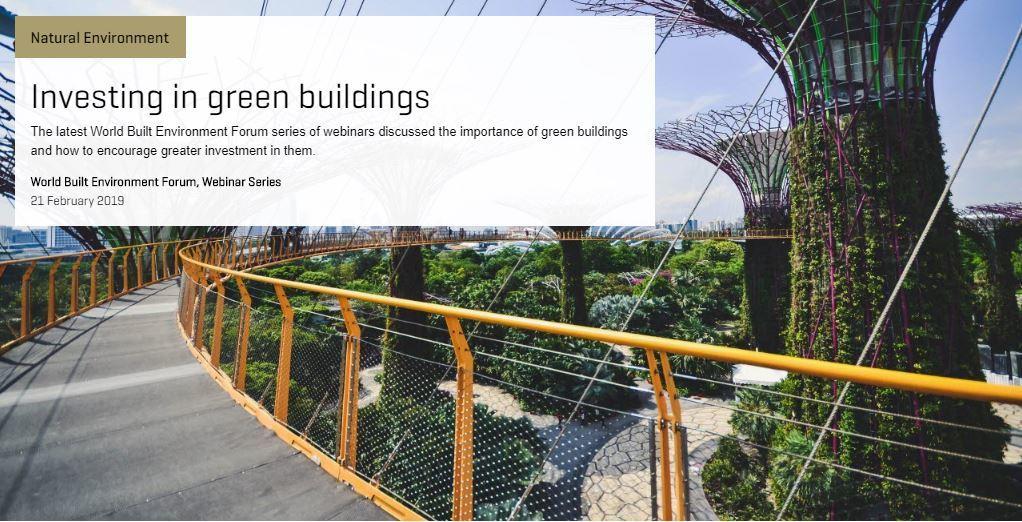Investing in Green Buildings
Laura Lindberg

The latest World Built Environment Forum series of webinars discussed the importance of green buildings and how to encourage greater investment in them.
The buildings sector is responsible for 30% of total final energy use around the world, more than half of global electricity consumption and one quarter of energy-related CO2 emissions.
Buildings are therefore central to national, regional and global commitments to combat climate change, such as the Paris Agreement on climate change.
The webinar discusses the importance of green buildings and how to encourage greater investment in them. From a commercial real estate perspective, this webinar will cover the integration of environmental, social, governance and climate risks into investment decisions, finance options for green buildings, and whether green buildings command a premium for investors.
The speaker line up for the webinar was:
- William Beloe, IFC Financial Institutions Group, Global Product Specialist, Climate Finance, International Finance Corporation
- Tatiana Bosteels, Director Responsibility for Private Markets and Head of Responsible Property Investment, Hermes Investment Management
- Cath Jackson, Senior Lecturer, Director of Learning and Teaching, Department of Urban Studies and Planning, The University of Sheffield (UK)
Investing in green buildings | Finance options and premia
Key takeaways from the webinar were:
There is no single definition of a green building, though some organisations have their own definition. For example, the International Finance Corporation (IFC), which is focussed on supporting the private sector in emerging markets, defines a green building as one that saves 20% of embodied energy (the total energy required) and water in its construction and operations.
There is an increasing trend to go beyond environmental aspects in defining a green building to incorporate other environmental, social and governance (ESG) criteria, such as wellbeing.
IFC has identified US$24.7 trillion of green building opportunities in emerging market cities in the next 11 years. The private sector will have to provide around 70-80% of the required finance as the sum is too large for the public sector to cover.
Buildings are a key part of financial institutions portfolios, but in many cases, green buildings only make up a small proportion, which is likely due to not having experience or understanding of them. Consequently, there is a need to help financial intermediaries identify where green building opportunities exist or are planned e.g. India or Brazil, and how they can differentiate themselves by developing specific financial instruments aimed at green buildings.
The importance of integrating environmental, social and governance and climate risks into investment decisions is threefold:
- the business case – to deliver long-term financial returns;
- in satisfying pension funds/insurance companies that their fiduciary risk from climate change is being addressed; and
- growing demand from occupiers for not only sustainability but also health and wellbeing aspects as well.
Real estate can move towards delivering intentional outcomes that support the Sustainable Development Goals in three ways:
- Meaningful placemaking – delivering cities that are sustainable not only in the sense of climate resilience or climate mitigation but also in ensuring jobs to support economic development and providing education facilities to support SDG;
- The incorporation of health and wellbeing; and
- The circular economy – the amount of resources being used by the real estate industry is significant and includes not only development and refurbishment but also occupancy – (approximately 40% of greenhouse gas emissions occur within buildings) so there is a need to embrace technologies and new ways of working to deliver what will be a considerable change in the way we build, manage and run buildings.
The overall opinion was that green buildings do provide a premium and this included quicker sales, a higher resale value, lower utility bills, lower default rates, and, for example, in the US lower interest rates on green mortgages, but quantifying the exact amount attributable to green measures was difficult in highly-specified buildings that had a number of other attractive features. A major UK study into green premia, that canvassed fund managers and asset managers in the UK two years ago, concluded that they found it hard or impossible to separate the impact of sustainability features from the general specification of the building.
Article first published on the World Built Environment - RICS



